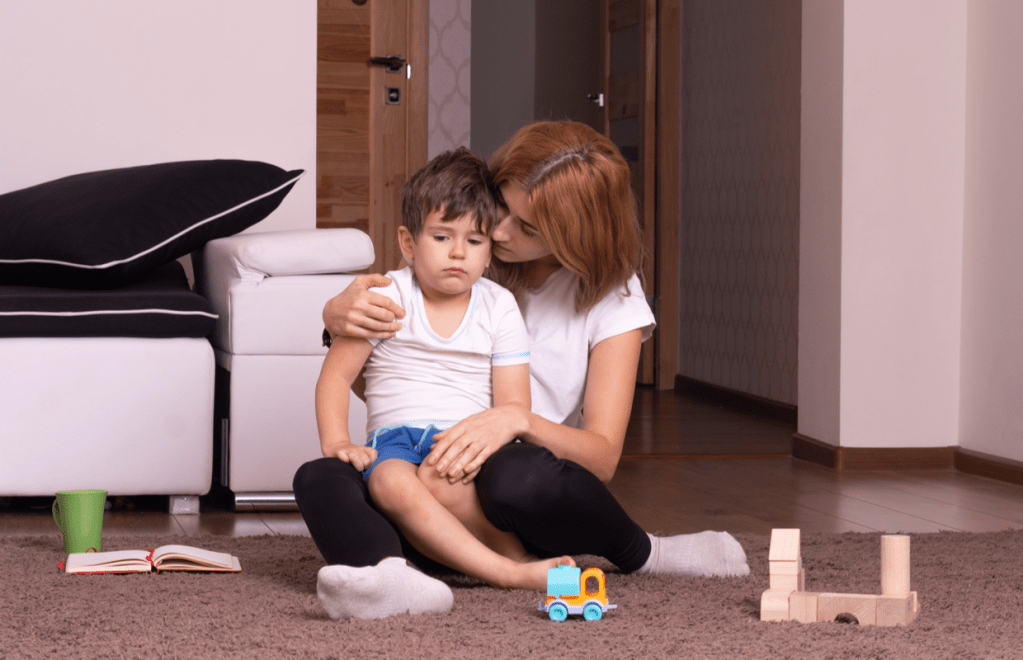How to help a child regulate their emotions
Discover how to help your child regulate and deal with confusing emotions, such as anger, fear and worry, with these top tips from clinical psychologist Dr Anne Lane...

Emotions are often given a bad name. ‘He’s so emotional’ we say, as our child reacts quickly (and loudly) to a seemingly simple request. ‘I can’t work out why she gets so stressed and uptight around swimming’ and ‘Why can’t he just stop teasing his brother?’ are similar oft-heard refrains when trying to help a child regulate their emotions.
But although your child’s emotions can be frustrating, confusing or even worrying to you as a parent, it’s important to remember that they play a vital role in their life and mental health. They help your child to judge situations, to communicate, and even to problem solve. When their emotions are working well, they allow creativity and mental agility, and the ability to foster a deep connection to others.
So how can you help your child develop, understand and regulate their emotions? One of the most important ways is through focusing on building up their emotional intelligence. This is a phrase we use to describe the process of developing emotional understandings and agility. When you help your child to understand, steady themselves and reflect on their emotions, you are supporting the growth of their emotional intelligence.
Labelling feelings and emotions
Central to the development of emotional intelligence is the ability to recognise and talk about emotions. This happens at a broad level when your child learns to label his or her experiences. Labelling helps your child to start recognising and regulating their emotions, and allows them to begin communicating with others. The emotions that are spoken about can then become more nuanced and adaptive.

How to help a child regulate difficult or intense emotions
Although labelling emotions is an important first step, it’s also essential to know what to do to help your child regulate emotions that are defensive and cause them to push others away, or prompt them to behave in ways that are difficult or harsh.
Perhaps your child gets tangled up in anxious thinking, so that it feels as if their emotions are constantly edgy and nervous. When your child’s emotions seem like this, your job is to go beyond simple labelling and help keep your child feeling safe and secure – whilst also guiding them to slow down and regulate their emotions.
Often, this means setting boundaries around destructive behaviours, whilst also maintaining a sense of connection and kindness. For example, you could say, ‘You seem upset. I won’t let you tease your sister, but I do want you to come over and be with me’.
Build an acceptance mindset to help a child regulate their emotions
It’s also important that you focus on developing an acceptance mindset. Difficult, tense emotions can be hard to bear. Our instinct is to try to solve them or make them go away but, in doing so, the emotion can simply take hold or become defensive.
Taking an acceptance mindset means that you aren’t trying to fix or solve the emotions your child is experiencing. Instead, you take an approach of openness and curiosity. You seek to understand and accept whatever feelings your child expresses, whether they be edgy, frustrated or defensive.
Your child might declare ‘I hate this house’ or ‘I’m not going to X’s tomorrow’. Rather than thinking of these statements as problems, welcome them as an opportunity to gain greater understanding, and to reflect. You might say, ‘You sound really fed up. Tell me why’. The simple act of being openly listened to allows your child’s emotions to settle. In turn, you can help them attend to the softer, more vulnerable emotions hidden behind those defensive, noisy behaviours.
An acceptance mindset might sound like:
- ‘I want to hear all about this….’
- ‘Can you help me understand…’
- ‘Your emotions make sense…’
- ‘I don’t want to rush in and fix things, or try to get you to change…’

5 important steps to help children regulate their emotions
1. Ensure your child feels safe and supported
Labelling emotions happens best against a background context of support and acceptance. This is very important. Your open, steady presence helps your child understand that he or she is safe and secure, and helps reassure them that their emotions are not frightening or problematic. When your child feels secure and accepted, they are much more able to reflect on how they feel, and to focus their attention.
2. Start with the basics and don’t be too prescriptive
With younger children, it can be helpful to start with labels that are either very basic – such as happy, cross or sad – or that help them connect with the physical experience of an emotion (for example, ‘wobbly inside’). Don’t worry if the description isn’t a ‘classic’ emotion label. Your child will slowly develop a wider vocabulary.
3. Use labels that invite connection
Labelling an emotion as ‘worried’ or ‘sad’ invites reflection, whereas ‘annoyed’ or ‘angry’ or ‘irritated’ can shift attention away from your child’s needs. This doesn’t mean you can’t use these labels; anger has an important place in your child’s emotional world, but it needs to be balanced with labels that allow a child to come back to the more vulnerable feelings.
4. Developing more nuanced understandings
As your child gets older, you can use more nuanced labels, such as embarrassed, nervous or isolated. They will also benefit from hearing mixed labels. For example: ‘grumpy-excited’ or ‘lonely-worried’. Recognising that we can experience different emotions at once will give your child the ability to work through and regulate them. Often, recognising where they might be stuck requires more than one label.
5. Prioritise your child’s preferences
It can be tempting to think you know what your child’s emotions mean. I remember an old school teacher insisting that I was ‘lonely’ when my friend left for a new school. But the label didn’t sit easily with me; it brought up other associations and meanings. I much preferred it when a lunchtime supervisor commented, ‘You’re feeling a bit lost without your old buddy’.
The associations you have to an emotion word can be very different to those held by your child. Be careful to listen to feedback from your child as you seek to help them regulate their emotions. Thinking about other terms, if a particular word or phrase doesn’t seem to fit, means your child feels more understood and connected to. They understand and recognise the feeling described more, and they feel more at ease.

How to develop meaningful conversations with your child about emotions
If an opportunity to talk presents itself, grab it. The best conversations are those your child initiates. Of course, this is often when you have least space. It might be just as you’re rushing to get dinner on the table, or about to wash the dog. But as soon as your child shows an interest in talking, try to stop what you’re doing and go for it.
Talk 50 per cent less than you would normally. Especially when you’re talking about how to regulate emotions, let your child take up most of the space. Be quieter, and less opinionated than you might be if you were speaking with another adult.
Don’t push for information – if your child is reluctant, then acknowledge this. Say: ‘It doesn’t feel like it would be good to talk right now,’ or ‘It feels hard to try and put words to these feelings.’ Let your child know that talking can take time – give them a hug if they are comfortable with touch, and then come back to the discussion at another time.
If your child gets stuck in anxious thinking and conversations tend to focus on risks or ‘what-ifs’, shift away from verbal reassurance and focus instead on helping him or her to feel safe and supported in the present moment. You might say, ‘You’re feeling so much anxiety and worry. I’m here with you; you’re safe.’
Don’t take his or her feelings personally. Defensive, tight emotions can feel angry and attacking, but this is just their outer shell. Underneath, your child ultimately wants to be seen and heard and acknowledged. Notice if you are feeling hurt or invalidated too. Be gentle with yourself, but know that these emotions will soften and balance once they are listened to and opened out.
Prompts to help you child talk about their emotions:
Connecting and soothing:
- ‘I can see you’re having a hard time’
- ‘I’m here sweetheart’
- ‘Everything feels too much’
Opening up conversations:
- ‘Yes, I see’
- ‘So, what you’re saying is…’
- ‘Am I getting this right…?’
- ‘That makes sense to me’
- Or just ‘Uh-huh’ and ‘… Hmmm’
Helping your child find words:
- ‘You feel annoyed because….’
- ‘I think I would feel upset if that was to happen to me…’
- ‘Does that make you feel anxious, or how would you describe it?’
Next steps:
- Journal: Encourage children to reflect on their feelings with the Happy Self Journal (£22.40).
- Read: Nurture Your Child’s Emotional Intelligence by Dr Anne Lane (£12.99), and teach them crucial life skills.
- Discover: youngminds.org.uk, a fantastic collection for family life.








